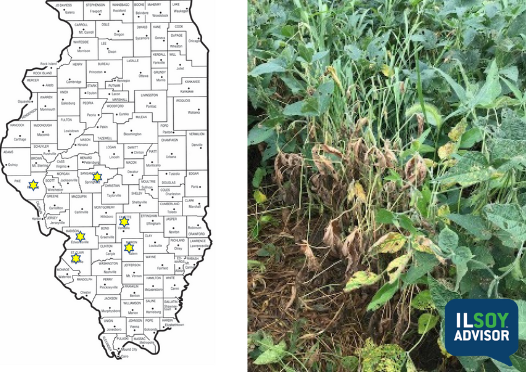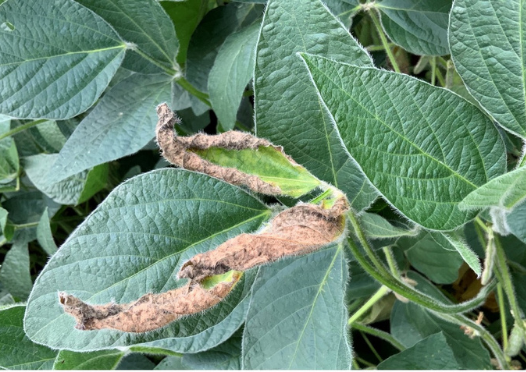ILSOYADVISOR POST
Disease Risk in 2015
This has been a wet season for soybeans with frequent rains, water ponding, saturated soils, and cool and cloudy conditions, while being warm and humid. These are the sorts of conditions that let diseases flourish in crops. We have already been hearing about the need to spray fungicides on corn because of earlier than normal outbreaks of gray leaf spot and northern corn leaf blight. Will soybeans also experience heavier than normal disease pressure this year?
Let’s look at the disease triangle. Diseases need a pathogen (disease), host (soybean) and an environment conducive to disease development. 2015 is a season conducive to disease development because of the wet conditions and high humidity. And there are plenty of soybeans planted across the state. But will we be seeing disease outbreaks in soybeans? It is hard to predict exactly, but there is a high chance.
There are a number of diseases that can impact soybeans during the summer which are influenced by wet weather and create greater risk. Below are the diseases to be on the lookout for.
Sudden death syndrome (SDS) that infects the soybean crown during emergence but doesn’t show up until August. Conditions are right at emergence for an infection to occur, and it appears they will be right for symptoms to appear in August with the warm, humid weather conditions. There is no foliar spray that control SDSs. However, Bayer CropScience has a new seed treatment, ILeVO, that provides some control.
White mold is a threat mainly to northern Illinois crops when soil conditions are wet during flowering. Conditions are right at flowering for an infection to occur and it appears they will be right for symptoms to appear in August with the wet and humid weather conditions and the tight canopy with little air movement. Now is the time to make a decision regarding white mold fungicide applications; but remember, fungicides aren’t a silver bullet for white mold management. The following fungicides have been labeled for white mold control: Topguard, Proline, Domark, Topsin-M, Endura and Aproach, but control varies considerably.
Septoria brown spot is common in soybeans and you can usually find it in a soybean crop at very low levels. However, like most diseases it likes warm and humid conditions. Brown spot is most severe when soybeans are grown continuously in the same field and have areas with poor drainage. Foliar fungicides will provide control if you are spraying for other diseases.
Probably the number one foliar disease seen in Illinois is Frogeye leaf spot. Since the pathogen overwinters and survives on residue, a large numbers of spores are produced in warm, humid weather. The spores begin to germinate within an hour when free water is present. They are carried by wind current and infect the plant and neighboring plants throughout the season under wet and humid conditions. Foliar fungicides are an effective means of control.
There are other diseases like downy mildew and Cercospora blight and leaf spot (purple seed stain) and a few others but there is a relatively minor risk compared to the above.
Agronomist Dr. Daniel Davidson posts blogs on agronomy-related topics. Feel free to contact him at djdavidson@agwrite.com or leave a comment below.





Comments
Add new comment